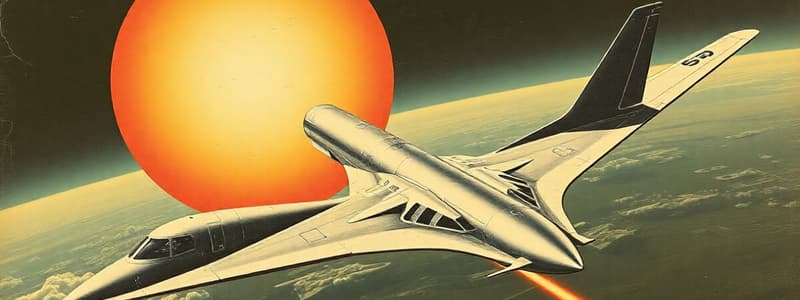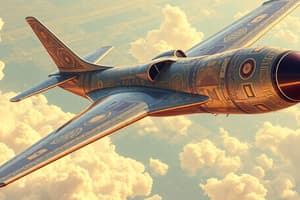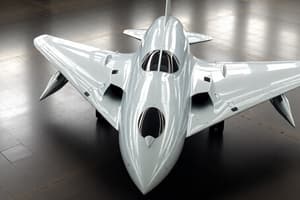Podcast
Questions and Answers
What is the primary goal of NASA's QueSST mission, as exemplified by the X-59 aircraft?
What is the primary goal of NASA's QueSST mission, as exemplified by the X-59 aircraft?
- To develop aircraft capable of reaching speeds exceeding twice the speed of sound for military applications.
- To create quieter aircraft by relocating engine noise away from populated areas.
- To test advanced camera technology in place of traditional cockpit windows.
- To engineer a supersonic aircraft that mitigates the disruptive sonic boom, enabling overland supersonic travel. (correct)
Which design feature of the X-59 most directly contributes to the reduction of the sonic boom?
Which design feature of the X-59 most directly contributes to the reduction of the sonic boom?
- The removal of the forward-facing cockpit window.
- The long, pointed nose of the aircraft. (correct)
- The relocation of the engine to the top of the aircraft.
- The implementation of advanced camera systems for piloting.
The Concorde, the world's first supersonic passenger airplane, faced operational limitations primarily due to what factor?
The Concorde, the world's first supersonic passenger airplane, faced operational limitations primarily due to what factor?
- Technological limitations in achieving sustained supersonic speeds.
- High operational costs and fuel consumption.
- The inability to fly at top speeds over land due to the disturbance caused by the noise. (correct)
- Stringent international regulations on aircraft emissions.
Why is community feedback crucial to NASA's testing phase of the X-59 over select U.S. cities?
Why is community feedback crucial to NASA's testing phase of the X-59 over select U.S. cities?
What is the anticipated impact of the X-59's success on the future of commercial aviation?
What is the anticipated impact of the X-59's success on the future of commercial aviation?
How does the X-59 address the challenge posed by the absence of a forward-facing window in the cockpit?
How does the X-59 address the challenge posed by the absence of a forward-facing window in the cockpit?
Considering the X-59's design and mission objectives, which of the following is the most likely reason for placing the engine on top of the aircraft?
Considering the X-59's design and mission objectives, which of the following is the most likely reason for placing the engine on top of the aircraft?
The article mentions that supersonic speed is about 768 mph (1,236 km/h). Which of the following scenarios would most likely produce a sonic boom, based on this information?
The article mentions that supersonic speed is about 768 mph (1,236 km/h). Which of the following scenarios would most likely produce a sonic boom, based on this information?
Flashcards
Supersonic Speed
Supersonic Speed
Speeds faster than the speed of sound, roughly 768 mph (1,236 km/h).
Sonic Boom
Sonic Boom
An intense sound produced when an aircraft exceeds the speed of sound.
QueSST
QueSST
NASA's project to develop technology for quieter supersonic flight.
X-59's Long, Pointed Nose
X-59's Long, Pointed Nose
Signup and view all the flashcards
Engine Placement on Top (X-59)
Engine Placement on Top (X-59)
Signup and view all the flashcards
X-59's Camera System
X-59's Camera System
Signup and view all the flashcards
X-59 Testing Phase
X-59 Testing Phase
Signup and view all the flashcards
X-59's Potential Impact
X-59's Potential Impact
Signup and view all the flashcards
Study Notes
- NASA's X-59 aircraft aims to revolutionize air travel by achieving supersonic speeds without the loud sonic boom.
Design and Purpose
- Revealed in January 2024, the X-59 is part of NASA's Quiet SuperSonic Technology (QueSST) mission.
- The goal is to enable air travel over land at twice the speed, safely, sustainably, and with significantly reduced noise.
Supersonic Speed and Sonic Boom
- Supersonic speed exceeds the speed of sound, approximately 768 mph (1,236 km/h).
- Breaking the sound barrier typically results in a sonic boom, which can be disruptive and damaging.
- The sonic boom was a major factor that contributed to the limited usage and failure of the Concorde.
- The Concorde could only fly at top speeds over the ocean due to noise restrictions.
X-59's Unique Features for Quiet Supersonic Flight
- Long, pointed nose: Designed to break up shock waves that cause the sonic boom.
- Cockpit design: Eliminates the forward-facing window; the pilot uses advanced cameras instead.
- Engine placement: Positioned on top of the aircraft to direct noise away from the ground.
Testing and Future Plans
- NASA plans to begin testing the X-59 in California in late 2024.
- After safety evaluations, the X-59 will be flown over select U.S. cities to gather community feedback on the sound levels.
- The data collected aims to influence airline officials to reconsider the prohibition of supersonic flights over land.
- If successful, the X-59 could lead to the development of new commercial cargo and passenger supersonic aircraft by 2030.
Studying That Suits You
Use AI to generate personalized quizzes and flashcards to suit your learning preferences.
Description
NASA's X-59 aircraft, part of the QueSST mission, aims to achieve supersonic speeds without creating disruptive sonic booms. Its unique design, featuring a long, pointed nose, will break up shock waves. The goal is to enable faster overland air travel while minimizing noise impact.





